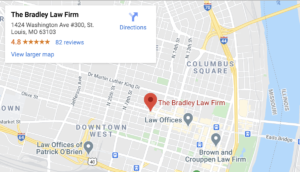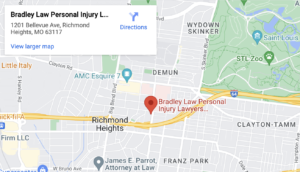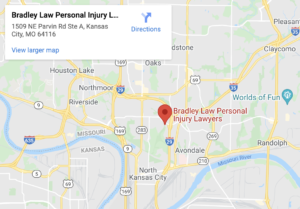
Negligence is when a person fails to use the required level of care that a reasonable would exercise under the same circumstances. Negligence may be an action or an omission to act.
To demonstrate negligence, a plaintiff must prove four elements:
- The defendant owed a duty of care to the plaintiff;
- The defendant breached that duty;
- The breach was the actual and proximate cause of the plaintiff’s injury; and
- The plaintiff suffered damages as a result of the breach.
These elements, while fairly standard across the United States, differ slightly in Missouri.
Table of Contents
Duty
The first element involved in whether a duty existed between the plaintiff and the defendant. To be found liable, the defendant must have had a legal obligation to prevent the plaintiff from injury.
A person owes a duty if:
- A Missouri statute or regulation imposes it;
- It is created by the relationship between the parties, or because under a given set of circumstances, the defendant must exercise the required standard of care to avoid foreseeable injury; or
- The defendant has assumed duty through a contract.
There are three standards of care in Missouri, which differ depending on the parties’ relationship or the case’s particular circumstances.
The most common duty owed is that of ordinary care. For example, an elevator repair company owes this duty to elevator passengers. The second degree is the duty of the highest degree of care. This degree is owed by automobile drivers to other drivers on the road and nearby pedestrians. Finally, the third degree of duty is the degree of ordinary skill exercised by professionals. This duty is used in medical malpractice cases.
See generally, Davidson v. Otis Elevator Company, 811 S.W.2d 802, 803-04 (Mo. Ct. App. 1991).
Breach of Duty
Once the plaintiff establishes that a duty existed between the defendant and plaintiff, they must prove the defendant breached their duty. A defendant breaches their duty by violating the applicable standard of care.
For example, assume a person is driving their car on I-55 but is not paying attention and is texting. The driver loses control and swerves across the median, colliding with a pick-up truck in the oncoming traffic. The pick-up driver is severely injured.
In this case, the car driver likely breached their duty to exercise the highest degree of care by texting and driving. A reasonable person exercising the highest degree of care while driving would not text while operating a motor vehicle.
Causation
The defendant’s breach of duty must cause the plaintiff’s harm. In Missouri law, there are two components to causation – cause-in-fact and proximate cause.
Cause-In-Fact
This is also called the “but for” test or “actual cause.” Cause-in-fact means that the injury would not have occurred but for the defendant’s conduct. If a plaintiff can show they would not have their injuries without the defendant’s act or omission, they have established cause-in-fact.
Proximate Cause
Proximate cause exists if the injury caused by the defendant’s breach of duty naturally flows from the defendant’s conduct. In other words, it’s a foreseeability test and is concerned with fairness. Proximate cause limits the plaintiff from claiming events in the chain of causation caused their injuries if the events were too remote (e.g., but for the defendant’s mother giving birth to the defendant, the plaintiff would not have experienced injury).
Was the injury a reasonably foreseeable result of the wrongdoer’s conduct? The classic example from Palsgraf v. Long Island Railroad illustrates this concept.
The plaintiff, Ms. Palsgraff, was waiting on a railroad platform at the railroad station when an incoming train arrived. A fair distance away, a person ran to catch the train. He was carrying a package, which he dropped when he fell trying to board the train. Two railroad employees intervened and tried to prevent him from falling, but they were unsuccessful.
It turns out there were fireworks in the package that the passenger dropped. The package exploded when it hit the ground, caused some scales to fall, and injured the plaintiff. She sued the railroad, alleging that the railroad employees who had tried to prevent the passenger from falling acted negligently.
Ms. Palsgraf prevailed on the issue of negligence, proving all the elements, including proximate cause. But on appeal, the court struggled with the question of foreseeability. It concluded that Ms. Palsgraff was not a foreseeable injury victim of the railroad employee’s conduct. In other words, the foreseeable risk of negligently trying to prevent a passenger from falling extended only to those helping the passenger, the passenger, and those nearby – not someone standing at the other end of the station platform.
Damages
The plaintiff must prove that they suffered damages from the defendant’s breach of duty. There are two broad categories of damages available – compensatory and punitive.
Compensatory damages reimburse the plaintiff to replace what they have lost. The goal is to return the plaintiff back to the same position they were in before the accident happened. These damages include medical expenses, lost wages, lost earning capacity, pain and suffering, property damages, and others.
Punitive damages are designed to punish the defendant for their conduct. To be awarded punitive damages, the plaintiff must prove by clear and convincing evidence “that the defendant intentionally harmed the plaintiff without just cause or acted with a deliberate and flagrant disregard for the safety of others.” Mo. Rev. Stat. § 510.261.
Affirmative Defenses to Negligence
Even if the plaintiff proves the four elements of negligence, the defendant may raise an affirmative defense. This is a defense that may negate or reduce the defendant’s liability. Common affirmative defenses include comparative fault and assumption of risk.
Comparative Fault
After the plaintiff has established negligence, the defendant may present evidence that the plaintiff was partially or wholly at fault and bears some or all responsibility for their injuries. For example, assume a boat collides with a jet ski on a lake. The boat operator is injured. They sue the jet skier and prove their negligence case. A jury decides the plaintiff’s damages are $100,000. However, in their affirmative defense, the defendant jet skier proves that the plaintiff was 30 percent at fault. Therefore, the jury would reduce the plaintiff’s award to $70,000.
Missouri is a pure comparative negligence state. The law allows you to sue for damages even if you are 99 percent at fault for your own injuries. However, as in the example above, a jury will reduce your award by your percentage of fault.
Assumption of Risk
The defendant cannot be held liable when the plaintiff entered into a situation knowing there was a risk of harm. For example, when you play baseball, you’re assuming the risk that you might be hit by a baseball or injure yourself sliding into second base.
If the plaintiff expressly consents to accept the risk, this is called express assumption of risk. The defense is a complete bar to recovery. If the consent is implied, then the court may reduce their award.
Get Help with Your Negligence Claim
If you’re injured in an accident, you may have a negligence claim. Our experienced personal injury lawyer at Bradley Law Personal Injury Lawyers can help navigate the complexities of negligence law and pursue your claim in court, contact us today.




